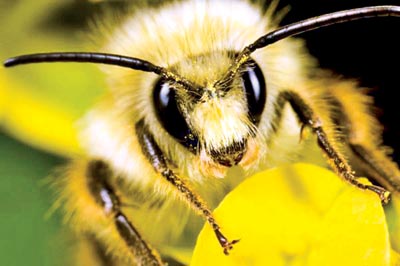|

Bees recognise human faces
Going about their day-to-day business, bees have no need to be able
to recognise human faces. Yet in 2005, when Adrian Dyer from Monash
University trained the fascinating insects to associate pictures of
human faces with tasty sugar snacks, they seemed to be able to do just
that. But Martin Giurfa from the University de Toulouse, France,
suspected that that the bees weren't learning to recognise people.
"Because the insects were rewarded with a drop of sugar when they
chose human photographs, what they really saw were strange flowers. The
important question was what strategy do they use to discriminate between
faces," explains Giurfa.
|

This insect with a microdot-sized brain can handle this type of
image analysis. |
Wondering whether the insects might be learning the relative
arrangement (configuration) of features on a face, Giurfa contacted Dyer
and suggested that they go about systematically testing which features a
bee learned to recognise to keep them returning to Dyer's face photos.
The team published their discovery that bees can learn to recognise the
arrangement of human facial features on January 29 this year in the
Journal of Experimental Biology teaming up with Aurore Avargues-Weber,
the team which first tested whether the bees could learn to distinguish
between simple face-like images.
Using faces that were made up of two dots for eyes, a short vertical
dash for a nose and a longer horizontal line for a mouth, Avargues-Weber
trained individual bees to distinguish between a face where the features
were cramped together and another where the features were set apart.
Having trained the bee to visit one of the two faces by rewarding it
with a weak sugar solution, she tested whether it recognised the pattern
by taking away the sugar reward and waiting to see if the bee returned
to the correct face. It did.
So the bees could learn to distinguish patterns that were organised
like faces, but could they learn to "categorise" faces? Could the
insects be trained to classify patterns as face-like versus non-face
like, and could they decide that an image that they had not seen before
belonged to one class or the other? To answer these questions, Avargues-Weber
trained the bees by showing them five pairs of different images, where
one image was always a face and the other a pattern of dots and dashes.
Bees were always rewarded with sugar when they visited the face while
nothing was offered by the non-face pattern.
Having trained the bees that 'face-like' images gave them a reward,
she showed the bees a completely fresh pair of images that they had not
seen before to see if the bees could pick out the face-like picture.
Remarkably they did. The bees were able to learn the face images, not
because they know what a face is but because they had learned the
relative arrangement and order of the features.But how robust was the
bees' ability to process the "face's" visual information? How would the
bees cope with more complex faces?
This time the team embedded the stick and dot faces in face-shaped
photographs.
Would the bees be able to learn the arrangements of the features
against the backgrounds yet recognise the same stick and dotted face
when the face photo was removed? Amazingly the insects did, and when the
team tried scrambling real faces by moving the relative positions of the
eyes, nose and mouth, the bees no longer recognised the images as faces
and treated them like unknown patterns.
So bees do seem to be able to recognise face-like patterns, but this
does not mean that they can learn to recognise individual humans. They
learn the relative arrangements of features that happen to make up a
face-like pattern and they may use this strategy to learn about and
recognise different objects in their environment. What is really amazing
is that an insect with a microdot-sized brain can handle this type of
image analysis when we have entire regions of brain dedicated to the
problem. Giurfa explains that if we want to design automatic facial
recognition systems, we could learn a lot by using the bees' approach to
face recognition.
Science Daily
Name: M. Glen Eugin
Dharshan
Gender: Male
Hobbies: Reading novels
and playing cricket
School: Highlands C.C.
Pen-friends preferred from:
Australia, India, USA, UK.
Age group: 11-13
Address: 97/R,
Dumbirikiriya, Upper Road, Hatton.
*********
Name: Michelle Andrea
Fernando
Gender: Female
Age: 15
Hobbies: Watching movies,
listening to music, playing the guitar, chatting with friends, reading
books, swimming.
Pen-pals preferred from:
Sri Lanka, USA, UK, Australia.
Age group: 16-20
Address: Q40 - 'Nivasipura',
Kotugoda, Ja-ela, Sri Lanka.
*********
Name: M. Luckshana
Gender: Female
Hobbies: Dancing, reading,
collecting paper cuttings, listening to music, playing games.
School: Highlands Central
College.
Pen-friends preferred from:
Australia, India, Canada, Singapore, Brazil, Maldives, Sweden.
Age group: 11-13
Address: 97/R,
Dumburigiriya upper road, Hatton.
*********
Name: Iresha Sandamali
Caldera
Gender: Female
Age: 15
Hobbies: Watching TV,
reading story books, playing computer games.
Pen-pals preferred from:
Any country (especially from Australia)
Age group: 15-19
Address: 172/110,
Kurunduwatta-II, Elaboda Road, Gintota, Galle, Sri Lanka.
*********
Name: Dilthri Malsha
Mendis Wijesingha
Gender: Female
Age: 14
Hobbies: Listening to
music, playing, reading story books
School: K. Dhamaloka Maha
Vidyalaya, Kalutara.
Pen-pals preferred from:
Sri Lanka, India, New Zealand, America.
Age group: 14-18 (girls or
boys)
Address: Alhankanda
Bombuwela, Kalutara South, Sri Lanka.
*********
Name: T. Harshya Kavingi
Peiris
Age: 14
Gender: Female
Hobbies: Reading books,
watching cricket matches
Pen-pals preferred from:
Sri Lanka, India, Australia, USA, UK, China, Japan, New Zealand,
Pakistan, Bangladesh.
Age group: 14-19
Address: No. 330, "Sanduni",
Walawwatta, Delgoda, Sri Lanka. |

